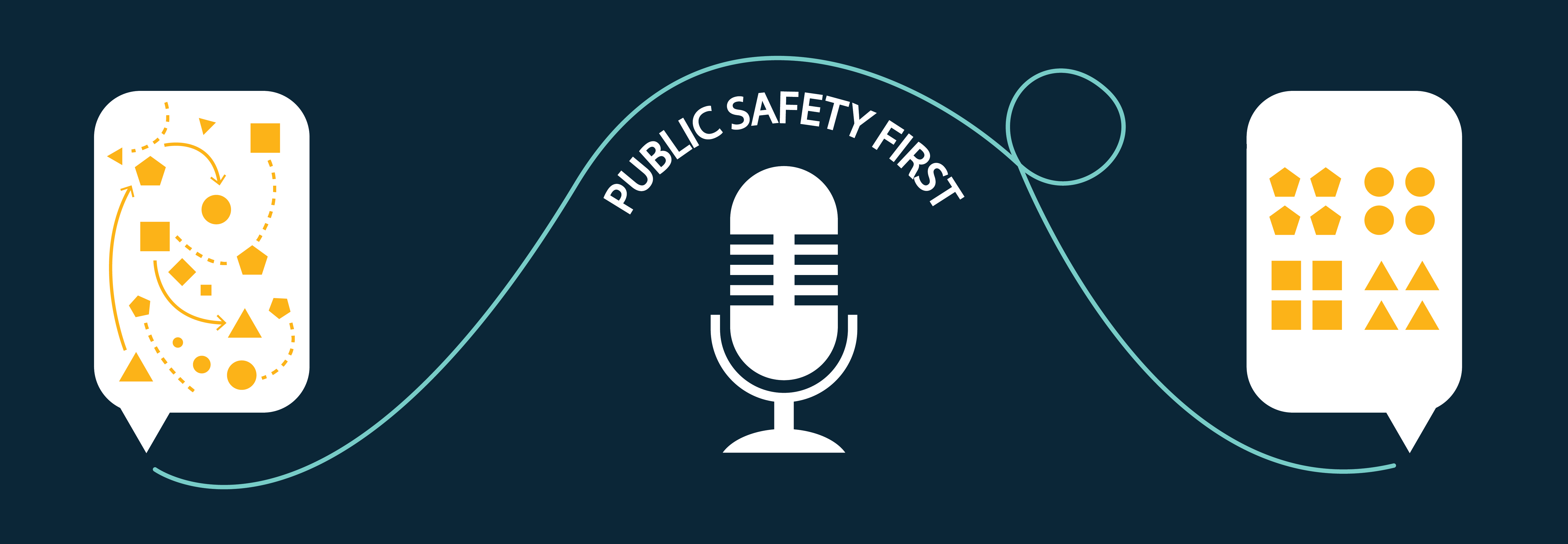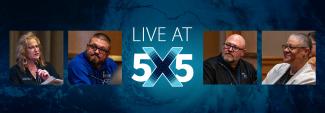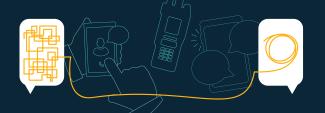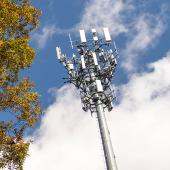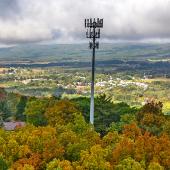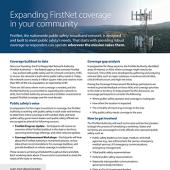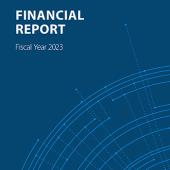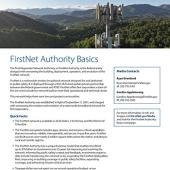Summary
Guest
Molly Hahn, FirstNet Authority Public Affairs Specialist
Mark Lipford, FirstNet Authority Senior Standards Engineer
Transcript
Preview
Narrator: You're listening to Public Safety First, a podcast to help you learn about the First Responder Network Authority and how you can be part of the future of public safety technology.
And now, your host.
Narrator: You're listening to Public Safety First, a podcast to help you learn about the First Responder Network Authority and how you can be part of the future of public safety technology.
And now, your host.
Molly Hahn: Welcome to another edition of At Its Core, a FirstNet Authority podcast where we detangle and demystify technical topics so that the average person can understand them. I am Molly Hahn, a public affairs specialist here at the FirstNet Authority, and this podcast will truly set the standard for all the other podcasts moving forward, because we are here to talk about standards. And Mark Lipford is here to join me. Mark, welcome to the podcast. Why don't you take a moment and tell us about yourself and your role here at the FirstNet Authority.
Mark Lipford: All right. Good morning, Molly, and thank you for having me. As you said, my name is Mark Lipford. I've got over 35 years in telecommunications, and probably at least 30 of those years have been in wireless. So, I've got a little bit of a background. I've started out in the good old days of analog cellular, back when the favorite thing to say was, "Guess where I'm calling you from? My car." I've got experience working as a field engineer, working maintaining the equipment. I've done test and acceptance, systems engineering, deployments, actually done a little bit of product development. But for about the last 25 years, I've been focused on industry standards.
Molly Hahn: And so, Mark, you lead our efforts with standards. Can we just start with what are standards here at the FirstNet Authority, and how does this relate to what we do?
Mark Lipford: Sure. So, standards is something that a lot of people use and know, but they don't really realize what they're doing. One of the misconceptions is about them measuring or regulating stuff, but really, they define, "How do we do something?", and one of the simplest ways to explain it is if you think of a simple electrical plug you have in your home. You can buy a lamp, and you know it's going to plug into your house because those plugs have been standardized. It's just the way it works. Go to Europe, they've got a different type of plug, so it won't work. So, that's an example of regional standards where something works in a region. So, the U.S. is different than Europe is different than England is different than Australia, but they're all standardized for their regions. If you think of communication standards like what we do here at FirstNet, those are international standards. And, you may have an iPhone, you may have a Samsung Galaxy, you may be talking on T-Mobile, Verizon, AT&T, or the FirstNet networks. You could be using, you know, infrastructure from Nokia or Ericsson, could have Cisco involved, Samsung equipment, and they all work together. Why is that? It's because of standards. We define how all of those different vendors can work together to provide a common solution. So, that's kind of what standards are and why we need them. It's that multi-vendor involvement and engagement.
Molly Hahn: That's interesting, and having traveled overseas, I always get frustrated by not having the right plug. So, it is nice that when I have the most important thing in my life, my phone it works, and it works with everybody. I'm going to ask this question a lot today, but why? Why is the FirstNet Authority involved in this? I know it's written into our legislation. But why us?
Mark Lipford: Right. So, and you're right, the legislation and it came out of the tragic events of 9/11. And it was due to the poor ability for the different agencies responding to the events to communicate. And like you say, Congress created the legislation and part of that was to create a nationwide public safety network so that all of the different agencies could work together, communicate together. And even within that act, it was very explicit language around, it should be a standards-based technology. The network should be based on industry standards, and that the FirstNet Authority should be a leader and a driver in the development of that technology. So, you know, in very simple means that's why we're here, is because, you know, legislation says we should. And actually, driving the standards helps to reduce the cost because we get economies of scale. You know, we talk about mission critical push to talk. What we would be using here in the U.S. is the same as what is used in the Netherlands, in the United Kingdom, and Germany, in Korea. It's so the vendors can build it once, sell it globally. So, it's the economies of scale.
Molly Hahn: That's interesting. And again, you travel overseas and you think about okay, well I actually can just pay a little bit more and get my phone plan to work. And so, it's nice to know that we can kind of have that globally.
Who do we work with, when we talk about these standards? What kind of groups are we working with to push them throughout the world?
Mark Lipford: Right. So, there's several levels to that question, and I'll start at the top. There are two major standards organizations that we work with. The one here in North America is the North American International Standards Development Organization. It's called the Alliance of Telecommunications Industry Solutions, or ATIS, is the acronym we will often use. And with them, we have the opportunity to work in the Third Generation Partnership Project, or 3GPP. And that's the one you'll see most referenced globally. That's pretty much where all of the international wireless standards are developed. At those meetings, we work very closely with our FirstNet partner, AT&T, in helping create a unified need and direction of what we're going to push and do in these standards. But we also work with our vendor partners. We also work with other public safety agencies. Since FirstNet started working in standards over ten years ago, there's been a number of other countries that have also joined in. We work with the UK Home Office out of England. Another strong partner is the Netherland Police. There's also the German and Norwegian public safety agencies. We work with maritime agencies in Korea, the French ministry. I mean, you name it. We have very good working relationships with all of these agencies. So, it's really developed from just the U.S. trying to drive it for us to a true global effort.
Molly Hahn: You started to allude to it in terms of what we're starting to focus on, but what is the real focus and driver of what we're doing here with these standards? What are we looking at?
Mark Lipford: Okay. Great question. Standards, I mean, they make up a wealth of different types. There's all the different levels of the radio technology. There's the core infrastructure. Within 3GPP, there's easily 20 different working groups doing standards activities in different areas of focus.
Here at FirstNet, we focus really on four basic topics. And a lot of this is driven by our engagement activities, our outreach activities with the different public safety agencies and tribal agencies across the U.S. and its territories.
We look at coverage. What can we do in standards to enhance coverage? You'll hear a lot about proximity services and side link. This is allowing the device-to-device communication so that even if you're out of coverage, if you're near another device, they'll work a little bit like walkie talkies. We're also enhancing that to where you could actually use a relay device in between to where you could go from my device to another device to your device and never touch the network, but we can still communicate. You know, think of that like smokejumpers. If you're out in the middle of the wilderness where there's no coverage, but you still need to communicate. This gives you a perfect way of how you can do it. We can also use the relay service to go from the device to a relay back to the core network, so you can connect back to your home base or whatever if that's an option. So, it can extend coverage.
We focus on the mission critical services — your mission critical push to talk, your mission critical data, and your mission critical video. So, mission critical push to talk is the police officer pushing a button and communicating back with dispatch or doing something like that. So, we enable that. We create that capability. We've also expanded it to where if you're at a scene, you can have a group to where you don't have to talk to everybody in the city, but it's only for that group that's there at the scene. It doesn't pollute the airwaves away from the scene. So, the other people in the rest of the city can still focus on their jobs and not be distracted. And with mission critical data and mission critical video, it's an extension of that. We need to send data between each other, or we want to send situational video to each other. How do we do that? So, it's those types of things.
We look at enablers for these mission critical services and enhancements, where we can leverage broadcast multicast to save on resources, enhance location. So, we can provide not just two-dimensional location, but also what floor of the building is somebody on and how can we include that as we're doing push to talk so that we can keep track of the public safety officers? And again, the side link and some of those other capabilities, things that enable and make our mission critical services more valuable.
And then the final area is around resource management and availability. So, here at FirstNet we call it QPP: Quality of service, Priority and Preemption. So, we make sure that the network provides a good quality of service so that it's dependable. We give our public safety officers priority so that they will get the service when they need it. And then preemption takes advantage of that priority where it will interrupt, say, my phone call because I'm talking to my kids or something, and it lets the public safety officer get access to the resources because they're in a mission critical situation.
So, those are the areas that we look at. And, you know, when you think of the standards and you look at these different capabilities, I like to call it: we're putting tools in the public safety toolbox. You know, these are things that we can do, but how are they integrated for the user and how do they use them? That's based on the implementation and the needs of the officers. We don't define those. We just give them the capability and let them do what they need to do.
Molly Hahn: It sounds like you guys really do a lot here. And it's interesting to sit down here and learn about something that, you know, as an average user, I seem to think just works, and I don't have to think about it, and I'm not even in public safety. So, it's really great to hear from you, Mark. I think this work is so important, and it's excellent that we at the FirstNet Authority can really be the drivers of this. Is there anything else you want to share today with the podcast? You've really set a high bar for this, a high standard.
Mark Lipford: Thank you. It's been fun. You know, we are a small team from a standards perspective. But we're bringing close to 50 years of Standards experience. So, we've done an incredible job over the last 10 or 12 years, creating a sense of importance within the Standards environment. We were the first ones out there, and we are looked at as one of the leaders in the public safety standards. And so, I think, we've built a great reputation. And, our team, we're committed to the FirstNet mission, and we're dedicated to doing anything we can, you know, for the public safety officers. I mean, at the end of the day, our job is to make sure the guys get home every day to the safety of their home and to see their families. And that's what we're here for.
Molly Hahn: That's just excellent. I think it's these little things, and they're not so little, that we do that enable public safety to do their jobs is so important here at the FirstNet Authority. Thank you, Mark, for joining us and taking the time away from your busy day. And I look forward to keeping this conversation going. And I learned a lot. Thanks again.
Mark Lipford: All right. Thank you, Molly. Have a great day.
Narrator: Thanks for listening today. We're excited to have you join our podcast community. Make sure to subscribe on iTunes, SoundCloud, and YouTube. You can learn more about the First Responder Network Authority at FirstNet.gov and learn about FirstNet products and services at FirstNet.com.


